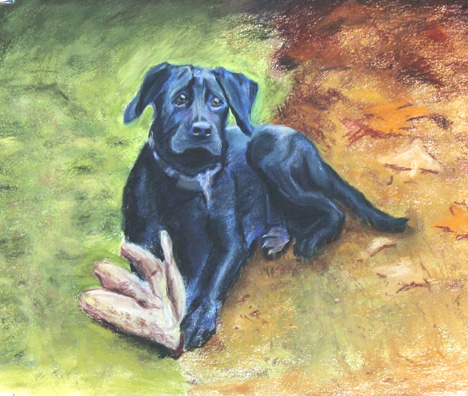Doeg

This doeg is in fact a Labrador retriever. And the rendering is in pastel.
Archeological evidence indicates dogs and humans have lived together since around 12,000 B. C. This was toward the beginning of the Paleolithic Era (New Stone age) and still long before the domestication of livestock. So the not terribly difficult conclusion to reach is that the first domesticated dogs were used for hunting.
Dogs, though, were also a means of protection. If you haven't noticed, they love to chase things and don't seem to care what it is. They are also capable of holding at bay large and dangerous animals - lions and tigers and bears. So if a band of hunters came across something that would hunt them, a couple of dogs could hold the larger animal off and give the humans time to get away.
Dogs are also hunters and they can easily chase down large game animals. But the distinctive characteristic of the domesticated dog from their wild cousins is that domesticated dogs are happy to chase and corner game animals but will hold off actually attacking it. Although the dogs could outpace their human owners, their barking indicated where and how far away the prey was. Hunting dogs don't have to be big either. One of the most absurd sights is to see a terrier chasing after a herd of cows with the cows high-tailing it around the field.
In return, dogs themselves found that living with people had its advantages. They could eat the same food as their owners and having people prepare your meals was something that dogs expect to this day. But dogs were also happy with the bits and parts that the people threw away. Although not seen so much today, it was once a common sight to see dogs happily munching on bones. They also adapted quickly to human dwellings and were happy just to lay around.
All dogs are descended from wolves and they now show more variety than any other species. Depending on the breed, a dog can weigh from 2 to 200 pounds. Their ears can stand up or be long and floppy. Tails bend down or curve up. Their faces can be long and sleek or flat and broad. But whatever a modern dog looks like, it looks like that because some person wanted it that way.
Exactly how dogs and people ended up being inseparable must remain conjectural. One suggestion is that humans would come across wolves who had brought down some large game animal. The humans - if there were enough - would drive the animals back and snitch some of the meat. Eventually the people would discard the bones a discreet distance from their settlements and the smaller of the animals would find that sticking close to people had its advantages. Eventually the more docile animals would lose its fear of humans and become what we think of as pets.
Complete domestication takes some time. Tests with foxes have shown that about 40 generations are needed to produce the familiar dog-like behavior - wagging tails, lolling tongues, and the like. But this experiment was carried out specifically with the idea of creating a domesticated animal. Going from a wolf to a happy tail-wagging dog could have taken millennia.
At one time dogs and wolves were considered separate species. A wolf was Canis lupus and a dog was Canis familiaris. But now dogs and wolves are lumped as subspecies of Canis lupus, with the dog - sorry, that's the doeg - being Canis lupus familiaris. Different subspecies of wolves have their own designation.
Why the dogs and wolves were designated separate species seems perplexing because it was well known that dogs and wolves could interbreed and produce fertile offspring. But "not-producing fertile offspring" includes "not producing any offspring because of any reason". The concept is not restricted simply to animals that have chromosomic mismatches.
Speciation is a complex process and concept. For instance, in some case fertile offspring may occur if a male mates with a female but not vice versa. Hence, the animals are different species. There are also different species where you will have the occasional random fertile offspring, but usually you don't.
We see, then that defining different species is not clear cut, and there are graduations of speciation. Some varieties of animals are widely dispersed geographically and are able to viably interbreed with the neighboring groups. But if you select animals at the ends of the geographic distribution, you'll find they cannot biologically produce offspring. This phenomenon has been observed most noticeably in wild donkeys in Africa.
Physical differences can also prevent producing offspring - and hence fertile offspring. One biologist pointed out that a Great Dane and a Chihuahua would best be considered separate species, and it is mainly for convenience that both are dubbed Canis lupus familiaris. In the wild they would be unable reproduce. So we do, despite some contrary claims, have a bonafide observable example of speciation, albeit one created by humans mucking about.
References
The Labrador Handbook: The Definitive Guide to Training and Caring for Your Labrador, Pippa Mattinson, Random House, October 1, 2015.
Dogs: History, Myth, Art, Catherine Johns, Harvard University Press, 2008,
"Why Are Different Breeds of Dogs All Considered the Same Species?", Nikhil Swaminathan, Scientific American, March 5, 2008.
"Man's New Best Friend? A Forgotten Russian Experiment in Fox Domestication", Jason G. Goldman, Scientific American, September 6, 2010